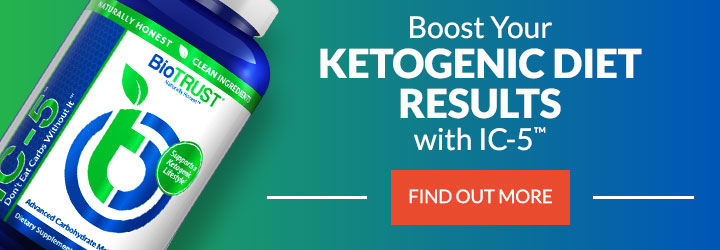Simple Tips to Maximize Your Ketogenic Diet Results

Okay, maybe you’ve read our Beginner’s Guide to the Ketogenic Diet. Perhaps you’ve taken a dive into our more in-depth guide on The Top Ketogenic Foods. Heck, you may have already started dabbling with keto…
Whether you’re entertaining the idea, just getting started, are already knee-deep into keto, in an effort to help you succeed, we wanted to take the next step with you and go beyond the basics.
While we’ll cover some of the common do’s and don’ts of keto in this blog post, if you’re truly committed to embarking on a successful journey with a keto lifestyle, then the first thing you need to do is get your hands on a copy of The Ketogenic Bible: The Authoritative Guide to Ketosis, written by Dr. Jacob Wilson and Ryan Lowery, PhD(c).1
This is the most comprehensive and useful resource on keto to date, and it’s filled with cutting-edge research (some of which the authors have conducted and published themselves), dozens of great-tasting recipes, helpful tips, and much, much more. This is such a critical evidence-based resource that it’s the basis for what you’ll find below. Don’t worry, I asked the authors if it was okay, and in his typical altruistic manner, Ryan said, “Of course! Let’s be the change!” #makepositivitylouder
Keto Flu
The ketogenic diet is a significant departure from “normal” for most people, whose bodies are heavily reliant on carbs. Adapting to keto—and switching to using primarily fat and ketones for fuel—can take some time. Think about it this way: You’ve been eating a certain way for the majority of your life, and your body has adapted accordingly (albeit in some negative ways). Even though you can change your diet overnight, the body takes time to adapt.
For some people, the adaptation period may be as short as a couple of weeks; for others, it may be more like four to six weeks. During this time, it’s not uncommon for people to experience some of the following issues, which are typically summarized as the “Keto Flu”:
- Brain fog
- Headache
- Nausea
- Muscle cramps
- Increased heart rate
- Fatigue
- Lethargy
- Feeling light-headed
- Difficulty sleeping
- Sugar cravings
- Digestive discomfort
- Constipation
The good news is—thanks especially to pioneers like Dr. Jacob, Ryan, and our very own resident keto expert Shawn Wells—we have some strategies that can help accelerate the adaptation period, mitigating or altogether eliminating symptoms of the keto flu. Here are some of those tips:
- Make sure you’re eating enough fat. Remember, keto is a high-fat diet. For many who’ve been brainwashed to believe that fat is bad, this can be a tough pill to swallow. As a result, we see quite a few people who don’t eat enough fat, which you’ll need to help you feel full and satisfied and to provide energy as your body adapts. Generally speaking, a ketogenic diet typically provides 70 – 80% of calories from fat. A consequence of not eating enough fat typically leads to another problem…
- Make sure you’re eating enough calories. Yes, if weight loss is the goal, then you need to burn more calories than you consume. However, dropping calories too drastically too quickly can contribute to most of the symptoms listed above. That doesn’t mean you have to be neurotic about your caloric intake, but it does mean you should keep it in mind, using it as a guide, making sure you’re not dipping too low too fast. If weight loss is your goal, then a more moderate 500-calorie-per-day deficit (on average) may be a good starting point.
- Watch your protein intake. It’s pretty easy to go a little too heavy on the protein, especially for those who are timid about their fat intake. Consuming too much protein may impair the body’s ability to make ketones (i.e., ketogenesis). Whether it’s through the process of converting excess protein to carbs (gluconeogenesis) or simply burning it for energy (prioritizing amino acids over fats), extra protein can reduce the body’s need to produce ketones. Protein can vary from 15 – 30% on the ketogenic diet.
- Watch your carbs. It’s easy to let carbs creep up, even if you’re being diligent about eating keto foods, including nuts, dairy, and even fruits and veggies. Remember, to force your body into full-fledged fat-burning keto mode, carbs need to be very low—usually below 30 grams per day.
- Stay hydrated. With keto, you quickly deplete your body’s stores of carbohydrates (called glycogen). With glycogen, your body also stores water (in about a 4:1 ratio in favor of water). In other words, when you restrict carbohydrates, you lose a lot of water. That’s one reason the number on the scale drops so quickly. Also, the drop in blood glucose and insulin signal to the kidneys to excrete more water. For these reasons, it’s crucial to drink plenty of water, as dehydration is one of the main explanations for several of the symptoms of the keto flu.
- Replenish electrolytes. Along with an increase in water excretion, keto typically leads to a depletion of electrolytes, namely sodium, potassium, magnesium, calcium, and chloride. This is in part due to a reduction in processed foods (the primary source of dietary sodium), and it also has to do with an increase in electrolyte excretion. If you’re exercising regularly, which we strongly recommend, then you should be getting 3 – 5 g/day of sodium and 2 – 3 g/day of potassium. For magnesium, 300 – 500 mg is a good target.
- Make sure you’re getting enough fiber. Fiber is important for many reasons, including good digestive health and laxation. Since you’ll be omitting many high-fiber foods with keto (like legumes and whole grains), make sure you’re eating plenty of dark green leafy vegetables, avocados, nuts, and seeds (e.g., chia seeds). If you need help getting enough fiber, which is typically recommended to be in the range of 25 – 35 grams per day, then you can consider adding a sugar-free psyllium fiber supplement.
- Exercise. Working out can be tough when starting keto, but truth be told, it’s one of the most effective ways to expedite the transition to becoming a fat-burning machine. According to research from Dr. Jacob and Ryan, high-intensity interval training (HIIT) leads to a greater increase in ketone production than steady-state cardio. Having said that, the keto experts say any exercise is better than none in accelerating the adaptation period.
- Watch your alcohol intake. You don’t have to completely eliminate alcohol on the ketogenic diet. After all, this is a lifestyle, and an occasional glass of dry red wine, low-carb drink, or beer isn’t a problem. However, most mixed drinks, most traditional beers, and many wines are high in carbs. That’s a problem in and of itself, but too many drinks usually lead to poor food choices as well. During the early stages of keto, it may be a good idea to limit all alcohol consumption, but after adaptation, moderate consumption of low-carb alcoholic drinks shouldn’t be a problem.
- Experiment with exogenous ketones. One of the latest developments in nutritional supplements is exogenous ketones, which can help jumpstart your reliance on ketones as your body ramps up its own production.
- Incorporate intermittent fasting. In the early 1900s, the ketogenic diet was designed to imitate the physiological state of fasting, which was particularly effective for treating seizures. Sure enough, there are two ways to ramp up ketogenesis: 1. Prolonged fasting; and 2. Severe carbohydrate restriction (i.e., keto). Along those lines, intermittent fasting—such as time-restricted eating (e.g., skipping breakfast) and alternate-day fasting—works synergistically with the ketogenic diet to boost ketone production and lower blood glucose and insulin.
- Push through it. Okay, that’s not the best piece of advice, but the point is that this too shall pass. Heck, some people, when implementing a well-formulated ketogenic diet, completely bypass the keto flu. And while each individual is different, this is just part of the process. Stick with it, and make sure you can check off all the boxes above, which can go a long way to ensuring the smoothest possible transition so you can start enjoying the bounty of benefits associated with keto.
Is Keto Healthy?
Lastly, one question we often see when it comes to the ketogenic diet pertains to safety. Invariably, when you mention the word ketosis, someone will ask, “Shouldn’t you be worried about ketoacidosis?” This is an important question to ask and discuss.
For starters, “nutritional ketosis” is a completely different physiological response than “diabetic ketoacidosis,” which is most commonly seen in type 1 diabetics. Whereas the former occurs during prolonged fasting or severe carbohydrate restriction (i.e., ketogenic diet) when glucose is unavailable, the latter is a state of uncontrolled production of ketones, which is often accompanied by very high concentrations of blood glucose. For an otherwise healthy individual, ketoacidosis is of no relevance.
Let’s lay out some additional numbers to help illustrate (in an otherwise healthy individual under fasting conditions):

As you can see, levels of ketone bodies are 3 – 50 times higher in the case of diabetic ketoacidosis, which is a pathological condition. On the other hand, the ketogenic diet results in a physiological state of nutritional ketosis that results in no change in blood pH, and thus, does not pose any inherent health risk to healthy individuals. Of course, it’s also important to discuss any changes in your exercise or nutrition plan with your healthcare professional.
As further evidence of the safety of the ketogenic diet, let’s consider what happened when researchers put 83 obese participants on a ketogenic diet for 24 weeks:
- A significant decrease in body weight and BMI
- A decrease in total cholesterol from week 1 to week 24
- A significant increase in HDL cholesterol levels
- A significant decrease in LDL cholesterol levels
- A significant decrease in the level of triglycerides
- A significant decrease in blood glucose
- No significant changes in the level of urea and creatinine
Based on the findings of this study, the researchers concluded, “The present study shows the beneficial effects of a long-term ketogenic diet. It significantly reduced the body weight and body mass index of the patients. Furthermore, it decreased the level of triglycerides, LDL cholesterol, and blood glucose, and increased the level of HDL cholesterol. Administering a ketogenic diet for a relatively longer period of time did not produce any significant side effects in the patients. Therefore, the present study confirms that it’s safe to use a ketogenic diet for a longer period of time than previously demonstrated.”
Now that you’ve gone beyond the basics, it’s time to dive headfirst into keto! Let us know if you have any questions, and please share your feedback. We’d love to hear about your experiences on keto.
Supercharge Your Diet Results with IC-5
IC-5, which is scientifically-designed to promote insulin sensitivity and improved carb tolerance, is one of our top diet-boosting supplement.
With IC-5, you know that you are supporting carbohydrate tolerance, keeping potentially harmful AGEs at bay, and amplifying the anti-aging effects of the ketogenic diet. It’s a triple threat for overall health and anti-aging!






